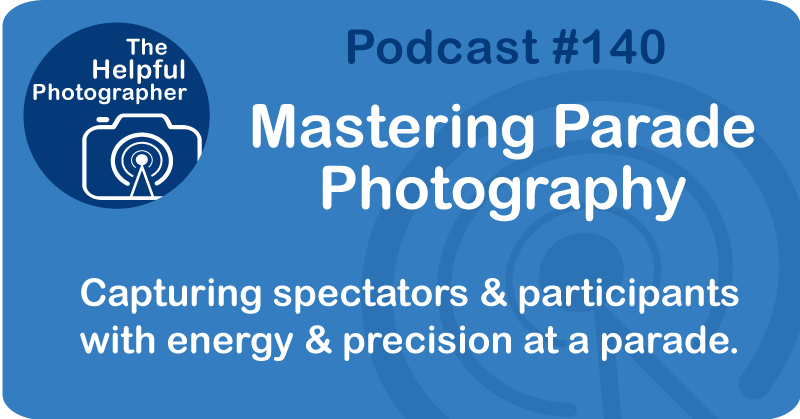Mastering Parade Photography #140

This pod is for Vicki in Tulsa. Vicki had a follow-up question: How do you photograph parades? I know it's tricky to discuss composition on a podcast because we don't have visual aids, but let's go.
As with any photograph, the first thing you need to ask yourself is: What do you want to convey? When it comes to parades, I think about two key elements: the spectators on the sidelines and the participants in the parade.
Let's start with the spectators. Parades are all about energy—kids waving flags, adults cheering, and just plain old fun. I want my photographs to reflect that. Very often, to convey that excitement, I want to show a big crowd. Be careful of your lens and angle choices—choose wrong, and you may make a large crowd look sparse. One trick to make a small crowd, or any crowd, feel larger is to use a long lens, something around 100 or 200 millimeters, or even longer. This compresses the scene and makes it look like there are more people. Look for groups of at least four to six people standing relatively close to each other, then focus on moments where things are happening, like people waving their hands, waving flags, or cheering. This will help capture that vibrant energy.
To tie the spectators to a parade rather than just a random crowd of people, try positioning yourself across the street and focus on the crowd. When the parade passes by, shoot through the gaps of people marching in the parade while keeping your focus on the spectators in the distance. That way, you're framing them as part of the parade's environment. Just remember, it's about capturing the fun and the energy of the crowd. Don't forget to get down low and photograph the children or maybe the pets who are also spectating. It's going to take a lot of timing and a lot of shots to get that right person in between the participants, but it'll be worth it.
Now let's talk about the participants in the parade. It always looks better when it feels like they're performing for a big crowd. To create that effect, find a spot where more people are in the background. Use a long lens to compress the scene, just like with the spectators. You might need to move back, which may be problematic because spectators could block your view, in which case a small step ladder to get above their heads will be helpful. You can also try shooting diagonally down the street for a more dynamic composition. In this case, you may want to go longer with your lens, perhaps around 300 to even 500 millimeters.
Whether you're photographing spectators or participants, pay attention to their actions and where they're looking. If they look in your direction, it can make the shot more engaging. Try waving back at people to see if they'll look your way. If it's a float with someone important, like the mayor in a classic car, zoom out to capture the whole car for context, but don't hesitate to zoom in on the person if it makes the shot more interesting.
As always, lighting is critical. Most parades happen midday, which makes lighting a challenge, but you can minimize problems by finding places with even light. Being in a place where the whole area is in the shadow of a building might give you some beautiful light on everything that passes by. Avoid places where a large tree may be casting mottled light on everyone, or where you may have very bright and very dark areas due to a partial shadow from a building.
As far as settings go, consider shooting in Shutter Priority mode. Parades are full of action, whether it's marching bands, baton twirlers, or cars rolling by, so you'll need a faster shutter speed to stop the action. Continuous focus will be important because your subjects will be moving towards or away from you. I would recommend shooting in burst mode, as it will give you a better chance of nailing the perfect moment. If you're using mirrorless, be careful of face detection autofocus—it might lock on to the wrong person, like a police officer walking beside the float instead of the mayor on top of it. To avoid that, consider setting a smaller focus area.
So keep in mind what you want to convey. Is it the energy of the crowd or the grandeur of the parade? Focus on that and let it guide your shot. Don't try to capture everything at once—stay focused on what you really want.










